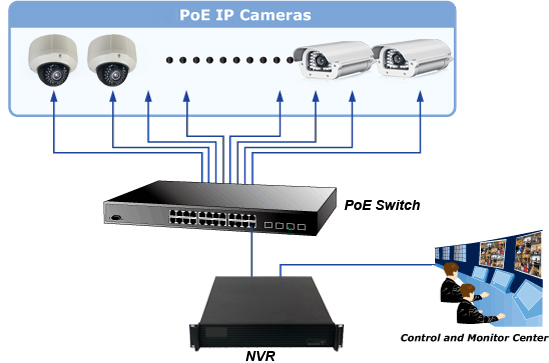Your present position:Home > Solution > PoE Solution for HD IP Camera Solution
PoE Function
In IP-based Surveillance System, POE allows a single cable to provide both electrical power and network data connection to IP Cameras.
PoE Advantage
• Data and power are combined on a single cable, which reduces cabling requirements. In most applications, existing network infrastructure can be used.
• PoE is simple to set up and because it operates at low voltage it does not require an electrician to install. User only need plug in the RJ45 jack to the port.
• Flexibility installation can be provided by PoE to locations where AC power would be inconvenient, expensive or infeasible to install.

PoE Standard
In an Ethernet cable, four twisted pairs are used as the medium for transmission, actually only two of the four pairs are needed for the commonly used. The PoE source can apply voltage either between the data pairs (pins 1–2 and 3–6), or between the two spare pairs (pins 4–5 and 7–8).All RIS Digital IP cameras can be able to accept power in either forms, so the form selected is not a concern, but Power must only be applied to one set of pairs at a time.

PoE Classifications
Class 1 -- 4.0 watts at PoE port; 0.44 to 3.84 watts at device
Class 2 -- 7.0 watts at PoE port; 3.84 to 6.49 watts at device
Class 3 -- 15.4 watts at PoE port; 6.49 to12.95 watts at device
Class 0 -- 15.4 watts at PoE port; 0.44 to 12.95 watts at device
Choose PoE Switch
Not all PoE switches are the same. Many switches cannot provide enough electrical current to power all ports simultaneously. So users need confirm whether the PoE switch you choose provide enough power per port for each IP camera. The maximum wattage of RIS Digital device can be found on its parameters. A true PoE switch should provide 15.4 watts of current simultaneously across all ports.